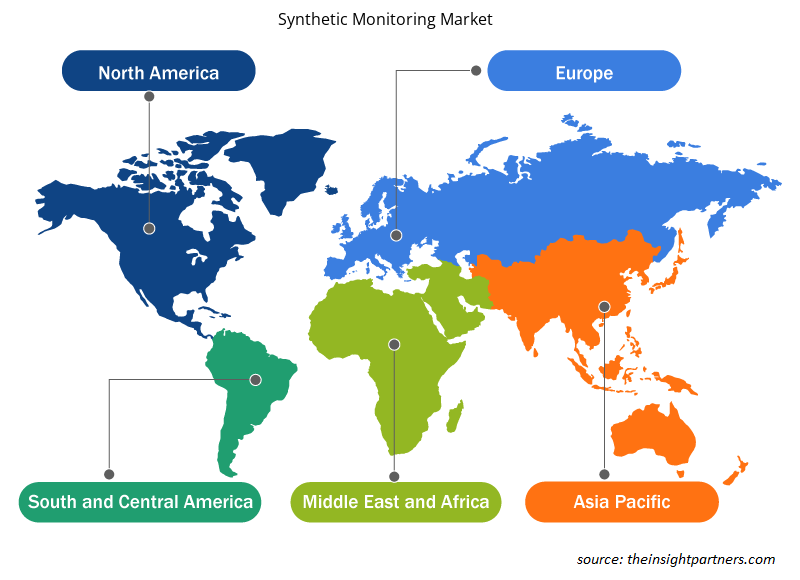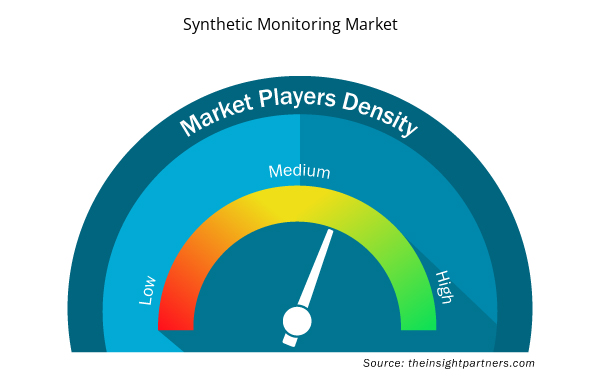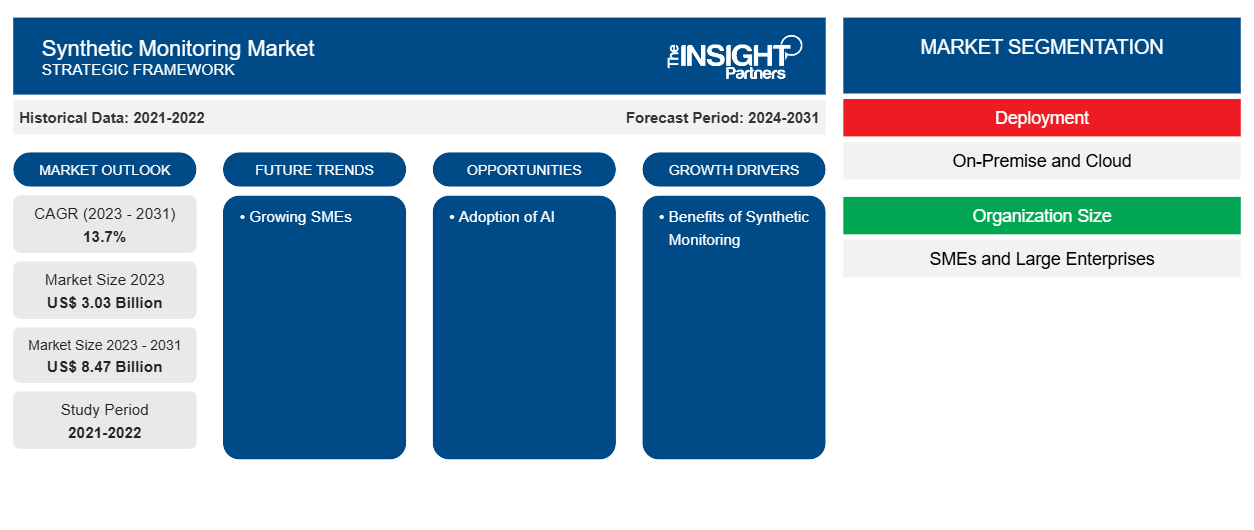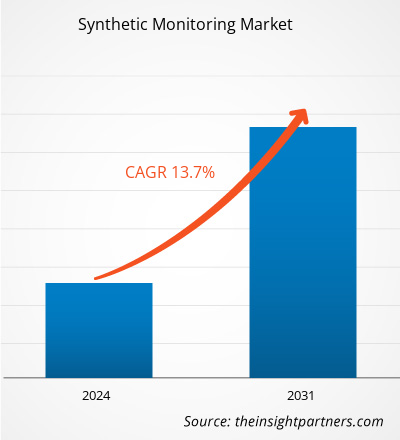من المتوقع أن يصل حجم سوق المراقبة الاصطناعية إلى 8.47 مليار دولار أمريكي بحلول عام 2031 من 3.03 مليار دولار أمريكي في عام 2023. ومن المتوقع أن يسجل السوق معدل نمو سنوي مركب بنسبة 13.7٪ في الفترة 2023-2031. ومن المرجح أن يظل التبني المتزايد للسحابة والارتفاع في الرقمنة مفتاحًا لاتجاهات سوق المراقبة الاصطناعية.
تحليل سوق المراقبة الاصطناعية
إن الدعم الحكومي لتعزيز قدرات الشركات الصغيرة والمتوسطة الحجم على أعمالها من خلال توفير المساعدات المالية والحوافز والمبادرات يمكن أن يساهم في تبني حلول البرمجيات مثل حلول المراقبة الاصطناعية. إن سوق السحابة المتنامية هي أحد العوامل الرئيسية التي تدفع سوق المراقبة الاصطناعية حيث تعد السحابة حلاً فعالاً من حيث التكلفة يؤدي إلى اعتماد حلول المراقبة الاصطناعية المستندة إلى السحابة من قبل العديد من الشركات الكبيرة والشركات الصغيرة والمتوسطة الحجم، مما يدفع سوق المراقبة الاصطناعية إلى الأمام.
نظرة عامة على سوق المراقبة الاصطناعية
يشير مصطلح المراقبة الاصطناعية إلى استخدام البرامج لمحاكاة تفاعلات المستخدم مع النظام. ثم يتم تحليل البيانات التي تم جمعها من المعاملات المحاكاة لتحديد كيفية عمل النظام. على سبيل المثال، يمكن استخدام المراقبة الاصطناعية لتحديد ما إذا كان موقع الويب يحقق تحميل الصفحة المطلوب ووقت الاستجابة ووقت التشغيل.
قم بتخصيص هذا التقرير ليناسب متطلباتك
ستحصل على تخصيص لأي تقرير - مجانًا - بما في ذلك أجزاء من هذا التقرير، أو تحليل على مستوى الدولة، وحزمة بيانات Excel، بالإضافة إلى الاستفادة من العروض والخصومات الرائعة للشركات الناشئة والجامعات
- احصل على أهم اتجاهات السوق الرئيسية لهذا التقرير.ستتضمن هذه العينة المجانية تحليلاً للبيانات، بدءًا من اتجاهات السوق وحتى التقديرات والتوقعات.
محركات وفرص سوق المراقبة الاصطناعية
فوائد المراقبة الاصطناعية لصالح السوق
تسمح حلول المراقبة الاصطناعية للمستخدم النهائي بالتنبؤ بكيفية استجابة النظام لطلبات المستخدم قبل تفاعل المستخدمين الفعليين معه. تسمح المراقبة الاصطناعية للمستخدم النهائي بالتحقق مما إذا كانت الأنظمة تلبي متطلبات الأداء والتوافر قبل الدخول في الإنتاج. في هذا الصدد، تسمح المراقبة الاصطناعية بالمراقبة الاستباقية . علاوة على ذلك، تعد المراقبة الاصطناعية مفيدة لتقييم استجابة النظام للطلبات غير العادية أو غير المتكررة التي قد لا يتم التقاطها في البيانات التي تم جمعها من المعاملات التي بدأها المستخدمون الحقيقيون. وبالتالي، تساعد المراقبة الاصطناعية في التحقق من صحة أداء النظام وتحديد المشكلات المحتملة قبل أن تؤثر على تجربة المستخدم النهائي. تمكن المراقبة الاصطناعية من المراقبة بشكل استباقي وتعالج مشكلات الأداء والتوافر قبل أن تعطل تطبيقات الإنتاج، مما يساعد المستخدمين النهائيين على تحسين تجربة عملائهم.
نمو سوق الشركات الصغيرة والمتوسطة
تستخدم الشركات أدوات مراقبة اصطناعية لمراقبة تطبيقات المؤسسة، وتوفر معلومات حول وقت التشغيل والأداء العام للمعاملات التجارية المهمة من خلال محاكاة العديد من أنشطة العملاء. تمكن هذه الأدوات الشركات من سد فجوات الأداء التي قد تؤثر على تجربة المستخدم النهائي الإجمالية. وبالتالي، فإن التحول الرقمي المتزايد والدعم الحكومي للشركات الصغيرة والمتوسطة الحجم يعزز قدرة الشركات الصغيرة والمتوسطة الحجم على تبني حلول برمجية لتعزيز كفاءة سير العمل لديها. وعلاوة على ذلك، مع اتجاه التحول الرقمي لتحسين الكفاءة التشغيلية الإجمالية وتجربة المستخدم النهائي، ستتبنى المزيد من الشركات الصغيرة والمتوسطة الحجم حلول المراقبة الاصطناعية في المستقبل.
تقرير تحليل تجزئة سوق المراقبة الاصطناعية
إن القطاعات الرئيسية التي ساهمت في اشتقاق تحليل سوق المراقبة الاصطناعية هي نشر الحبر، وحجم المنظمة، ونوع المراقبة، والصناعة.
- من خلال النشر، يتم تقسيم السوق إلى محلي وسحابي. ومن المتوقع أن ينمو قطاع السحابة بأعلى معدل نمو سنوي مركب.
- بناءً على حجم المنظمة، يتم تقسيم السوق إلى الشركات الصغيرة والمتوسطة الحجم والشركات الكبيرة. ومن المتوقع أن ينمو قطاع الشركات الصغيرة والمتوسطة الحجم بأعلى معدل نمو سنوي مركب.
- بحسب نوع المراقبة، يتم تقسيم السوق إلى مراقبة واجهة برمجة التطبيقات، ومراقبة تطبيقات SaaS، ومراقبة تطبيقات الهاتف المحمول، ومراقبة تطبيقات الويب . احتل قطاع مراقبة واجهة برمجة التطبيقات أكبر حصة في السوق في عام 2023.
- بناءً على الصناعة، يتم تقسيم السوق إلى قطاعات الخدمات المصرفية والمالية والتأمين والحكومة وتجارة التجزئة والرعاية الصحية وتكنولوجيا المعلومات والاتصالات وغيرها من الصناعات. ومن المتوقع أن ينمو قطاع التجزئة بأعلى معدل نمو سنوي مركب.
تحليل حصة سوق المراقبة الاصطناعية حسب المنطقة الجغرافية
ينقسم النطاق الجغرافي لتقرير سوق المراقبة الاصطناعية بشكل أساسي إلى خمس مناطق: أمريكا الشمالية، ومنطقة آسيا والمحيط الهادئ، وأوروبا، والشرق الأوسط وأفريقيا، وأمريكا الجنوبية/أمريكا الجنوبية والوسطى.
من المتوقع أن تنمو منطقة آسيا والمحيط الهادئ بأعلى معدل نمو سنوي مركب. ويؤدي انتشار تكنولوجيا الحوسبة السحابية في المنطقة إلى نمو سوق المنطقة. كما تعمل الشركات الصغيرة والمتوسطة الحجم المتنامية في المنطقة على تغذية الطلب على حلول البرمجيات في المنطقة، مما يدفع إلى استخدام تكنولوجيا المراقبة الاصطناعية. ويؤدي التحول الرقمي في الاقتصادات الناشئة مثل الهند والصين إلى اعتماد حلول المراقبة الاصطناعية في مختلف الصناعات التي تستهدف المستخدم النهائي.
رؤى إقليمية حول سوق المراقبة الاصطناعية
لقد قام المحللون في Insight Partners بشرح الاتجاهات والعوامل الإقليمية المؤثرة على سوق المراقبة الاصطناعية طوال فترة التوقعات بشكل شامل. يناقش هذا القسم أيضًا قطاعات سوق المراقبة الاصطناعية والجغرافيا في جميع أنحاء أمريكا الشمالية وأوروبا ومنطقة آسيا والمحيط الهادئ والشرق الأوسط وأفريقيا وأمريكا الجنوبية والوسطى.

- احصل على البيانات الإقليمية المحددة لسوق المراقبة الاصطناعية
نطاق تقرير سوق المراقبة الاصطناعية
| سمة التقرير | تفاصيل |
|---|---|
| حجم السوق في عام 2023 | 3.03 مليار دولار أمريكي |
| حجم السوق بحلول عام 2031 | 8.47 مليار دولار أمريكي |
| معدل النمو السنوي المركب العالمي (2023 - 2031) | 13.7% |
| البيانات التاريخية | 2021-2022 |
| فترة التنبؤ | 2024-2031 |
| القطاعات المغطاة | حسب النشر
|
| المناطق والدول المغطاة | أمريكا الشمالية
|
| قادة السوق وملفات تعريف الشركات الرئيسية |
|
كثافة اللاعبين في سوق المراقبة الاصطناعية: فهم تأثيرها على ديناميكيات الأعمال
يشهد سوق المراقبة الاصطناعية نموًا سريعًا، مدفوعًا بالطلب المتزايد من المستخدم النهائي بسبب عوامل مثل تفضيلات المستهلكين المتطورة والتقدم التكنولوجي والوعي المتزايد بفوائد المنتج. ومع ارتفاع الطلب، تعمل الشركات على توسيع عروضها والابتكار لتلبية احتياجات المستهلكين والاستفادة من الاتجاهات الناشئة، مما يؤدي إلى زيادة نمو السوق.
تشير كثافة اللاعبين في السوق إلى توزيع الشركات أو المؤسسات العاملة في سوق أو صناعة معينة. وهي تشير إلى عدد المنافسين (اللاعبين في السوق) الموجودين في مساحة سوق معينة نسبة إلى حجمها أو قيمتها السوقية الإجمالية.
الشركات الرئيسية العاملة في سوق المراقبة الاصطناعية هي:
- أبيكا
- شركة آب داينامكس المحدودة
- شركة برودكوم
- شركة ديناتريس المحدودة.
- شركة إي جي للابتكارات
- شركة آي بي إم
إخلاء المسؤولية : الشركات المذكورة أعلاه ليست مرتبة بأي ترتيب معين.

- احصل على نظرة عامة على أهم اللاعبين الرئيسيين في سوق المراقبة الاصطناعية
أخبار سوق المراقبة الاصطناعية والتطورات الأخيرة
يتم تقييم سوق المراقبة الاصطناعية من خلال جمع البيانات النوعية والكمية بعد البحث الأولي والثانوي، والذي يتضمن منشورات الشركات المهمة وبيانات الجمعيات وقواعد البيانات. فيما يلي قائمة بالتطورات في السوق:
- في يوليو 2023، قدمت Google المراقبة الاصطناعية، وهي قدرة مراقبة استباقية جديدة تستخدم نصوص Node.js الآلية لمحاكاة تفاعلات المستخدم مع تطبيق أو خدمة. يتيح لك هذا اختبار مدى توفر واتساق وأداء تطبيقات الويب وواجهات برمجة التطبيقات وتدفقات العمل التجارية الرئيسية من منظور مستخدم حقيقي على أساس دوري. في نوفمبر 2023، أعلنت Google عن التوفر العام للمراقبة الاصطناعية. بالإضافة إلى ذلك، مع هذا الإطلاق، تضمنت الشركة أيضًا قدرات جديدة للمراقبة الاصطناعية. (المصدر: Google، بيان صحفي، 2023)
- في مارس 2022، قامت Synthetic API Monitoring بتوسيع نطاق AppDynamics Synthetic Monitoring، مما مكن ITOps وDevOps من المساعدة في تقليل تأثير مشكلات أداء وتوافر واجهة برمجة التطبيقات على نتائج الأعمال وتجربة المستخدم. (المصدر: AppDynamics، بيان صحفي، 2022)
تغطية تقرير سوق المراقبة الاصطناعية والمنتجات النهائية
يوفر تقرير "حجم سوق المراقبة الاصطناعية والتوقعات (2021-2031)" تحليلاً مفصلاً للسوق يغطي المجالات التالية:
- حجم السوق والتوقعات على المستويات العالمية والإقليمية والوطنية لجميع قطاعات السوق الرئيسية التي يغطيها النطاق
- ديناميكيات السوق مثل المحركات والقيود والفرص الرئيسية
- الاتجاهات المستقبلية الرئيسية
- تحليل مفصل لقوى PEST/Porter الخمس وSWOT
- تحليل السوق العالمي والإقليمي الذي يغطي اتجاهات السوق الرئيسية واللاعبين الرئيسيين واللوائح والتطورات الأخيرة في السوق
- تحليل المشهد الصناعي والمنافسة الذي يغطي تركيز السوق، وتحليل خريطة الحرارة، واللاعبين البارزين، والتطورات الأخيرة
- ملفات تعريف الشركة التفصيلية
- التحليل التاريخي (سنتان)، السنة الأساسية، التوقعات (7 سنوات) مع معدل النمو السنوي المركب
- تحليل PEST و SWOT
- حجم السوق والقيمة / الحجم - عالميًا وإقليميًا وقطريًا
- الصناعة والمنافسة
- مجموعة بيانات Excel



Report Coverage
Revenue forecast, Company Analysis, Industry landscape, Growth factors, and Trends

Segment Covered
This text is related
to segments covered.

Regional Scope
North America, Europe, Asia Pacific, Middle East & Africa, South & Central America

Country Scope
This text is related
to country scope.
الأسئلة الشائعة
The global synthetic monitoring market was estimated to be US$ 3.03 billion in 2023 and is expected to grow at a CAGR of 13.7% during the forecast period 2023 - 2031.
The growing cloud adoption and rise in digitalization are the major factors that propel the global synthetic monitoring market.
Adoption of AI is anticipated to play a significant role in the global synthetic monitoring market in the coming years.
The key players holding majority shares in the global synthetic monitoring market are Apica, AppDynamics LLC, Broadcom Inc., IBM Corporation, and Micro Focus.
The global synthetic monitoring market is expected to reach US$ 8.47 billion by 2031.
The incremental growth expected to be recorded for the global synthetic monitoring market during the forecast period is US$ 5.43 billion.
Trends and growth analysis reports related to Technology, Media and Telecommunications : READ MORE..
The Insight Partners performs research in 4 major stages: Data Collection & Secondary Research, Primary Research, Data Analysis and Data Triangulation & Final Review.
- Data Collection and Secondary Research:
As a market research and consulting firm operating from a decade, we have published and advised several client across the globe. First step for any study will start with an assessment of currently available data and insights from existing reports. Further, historical and current market information is collected from Investor Presentations, Annual Reports, SEC Filings, etc., and other information related to company’s performance and market positioning are gathered from Paid Databases (Factiva, Hoovers, and Reuters) and various other publications available in public domain.
Several associations trade associates, technical forums, institutes, societies and organization are accessed to gain technical as well as market related insights through their publications such as research papers, blogs and press releases related to the studies are referred to get cues about the market. Further, white papers, journals, magazines, and other news articles published in last 3 years are scrutinized and analyzed to understand the current market trends.
- Primary Research:
The primarily interview analysis comprise of data obtained from industry participants interview and answers to survey questions gathered by in-house primary team.
For primary research, interviews are conducted with industry experts/CEOs/Marketing Managers/VPs/Subject Matter Experts from both demand and supply side to get a 360-degree view of the market. The primary team conducts several interviews based on the complexity of the markets to understand the various market trends and dynamics which makes research more credible and precise.
A typical research interview fulfils the following functions:
- Provides first-hand information on the market size, market trends, growth trends, competitive landscape, and outlook
- Validates and strengthens in-house secondary research findings
- Develops the analysis team’s expertise and market understanding
Primary research involves email interactions and telephone interviews for each market, category, segment, and sub-segment across geographies. The participants who typically take part in such a process include, but are not limited to:
- Industry participants: VPs, business development managers, market intelligence managers and national sales managers
- Outside experts: Valuation experts, research analysts and key opinion leaders specializing in the electronics and semiconductor industry.
Below is the breakup of our primary respondents by company, designation, and region:

Once we receive the confirmation from primary research sources or primary respondents, we finalize the base year market estimation and forecast the data as per the macroeconomic and microeconomic factors assessed during data collection.
- Data Analysis:
Once data is validated through both secondary as well as primary respondents, we finalize the market estimations by hypothesis formulation and factor analysis at regional and country level.
- Macro-Economic Factor Analysis:
We analyse macroeconomic indicators such the gross domestic product (GDP), increase in the demand for goods and services across industries, technological advancement, regional economic growth, governmental policies, the influence of COVID-19, PEST analysis, and other aspects. This analysis aids in setting benchmarks for various nations/regions and approximating market splits. Additionally, the general trend of the aforementioned components aid in determining the market's development possibilities.
- Country Level Data:
Various factors that are especially aligned to the country are taken into account to determine the market size for a certain area and country, including the presence of vendors, such as headquarters and offices, the country's GDP, demand patterns, and industry growth. To comprehend the market dynamics for the nation, a number of growth variables, inhibitors, application areas, and current market trends are researched. The aforementioned elements aid in determining the country's overall market's growth potential.
- Company Profile:
The “Table of Contents” is formulated by listing and analyzing more than 25 - 30 companies operating in the market ecosystem across geographies. However, we profile only 10 companies as a standard practice in our syndicate reports. These 10 companies comprise leading, emerging, and regional players. Nonetheless, our analysis is not restricted to the 10 listed companies, we also analyze other companies present in the market to develop a holistic view and understand the prevailing trends. The “Company Profiles” section in the report covers key facts, business description, products & services, financial information, SWOT analysis, and key developments. The financial information presented is extracted from the annual reports and official documents of the publicly listed companies. Upon collecting the information for the sections of respective companies, we verify them via various primary sources and then compile the data in respective company profiles. The company level information helps us in deriving the base number as well as in forecasting the market size.
- Developing Base Number:
Aggregation of sales statistics (2020-2022) and macro-economic factor, and other secondary and primary research insights are utilized to arrive at base number and related market shares for 2022. The data gaps are identified in this step and relevant market data is analyzed, collected from paid primary interviews or databases. On finalizing the base year market size, forecasts are developed on the basis of macro-economic, industry and market growth factors and company level analysis.
- Data Triangulation and Final Review:
The market findings and base year market size calculations are validated from supply as well as demand side. Demand side validations are based on macro-economic factor analysis and benchmarks for respective regions and countries. In case of supply side validations, revenues of major companies are estimated (in case not available) based on industry benchmark, approximate number of employees, product portfolio, and primary interviews revenues are gathered. Further revenue from target product/service segment is assessed to avoid overshooting of market statistics. In case of heavy deviations between supply and demand side values, all thes steps are repeated to achieve synchronization.
We follow an iterative model, wherein we share our research findings with Subject Matter Experts (SME’s) and Key Opinion Leaders (KOLs) until consensus view of the market is not formulated – this model negates any drastic deviation in the opinions of experts. Only validated and universally acceptable research findings are quoted in our reports.
We have important check points that we use to validate our research findings – which we call – data triangulation, where we validate the information, we generate from secondary sources with primary interviews and then we re-validate with our internal data bases and Subject matter experts. This comprehensive model enables us to deliver high quality, reliable data in shortest possible time.


 احصل على عينة مجانية لهذا التقرير
احصل على عينة مجانية لهذا التقرير